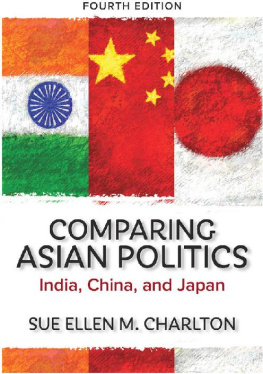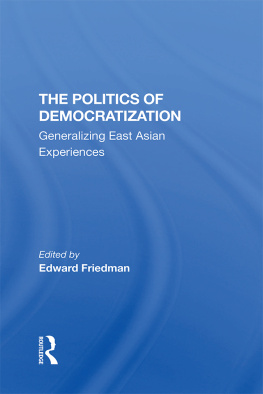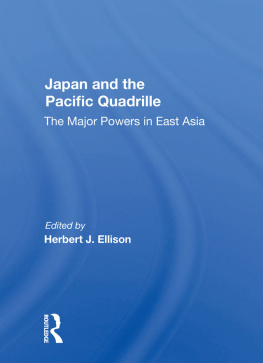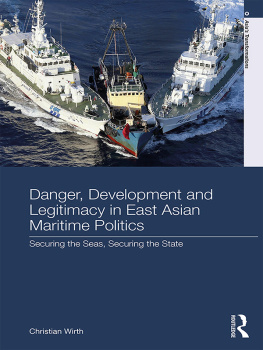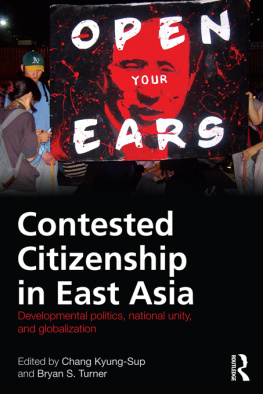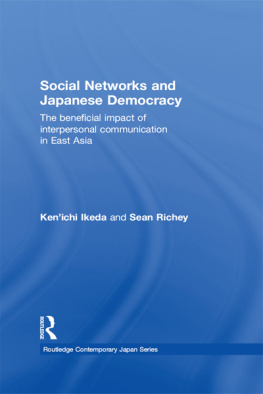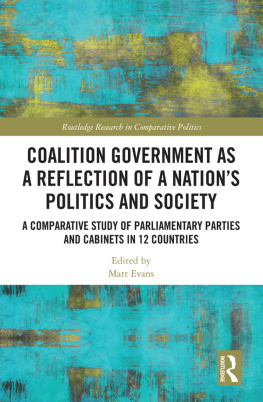COMPARING ASIAN POLITICS
Fourth Edition
Comparing Asian Politics
India, China, and Japan
Sue Ellen M. Charlton
First published 2015 by Westview Press
Published 2018 by Routledge
711 Third Avenue, New York, NY 10017, USA
2 Park Square, Milton Park, Abingdon, Oxon OX14 4RN
Routledge is an imprint of the Taylor & Francis Group, an informa business
Copyright 2015 Taylor & Francis
All rights reserved. No part of this book may be reprinted or reproduced or utilised in any form or by any electronic, mechanical, or other means, now known or hereafter invented, including photocopying and recording, or in any information storage or retrieval system, without permission in writing from the publishers.
Notice:
Product or corporate names may be trademarks or registered trademarks, and are used only for identification and explanation without intent to infringe.
Every effort has been made to secure required permissions for all text, images, maps, and other art reprinted in this volume.
Library of Congress Cataloging-in-Publication Data
Charlton, Sue Ellen M.
Comparing Asian politics: India, China, and Japan / Sue Ellen M.
Charlton.Fourth edition.
pages cm.
Includes bibliographical references and index.
ISBN 978-0-81334883-4 (paperback)ISBN 978-0-8133-4884-1
(e-book) 1. AsiaPolitics and governmentCase studies. 2. India
Politics and government. 3. ChinaPolitics and government. 4. Japan
Politics and government. I. Title.
JQ24.C48 2014
320.3095dc23
2014008802
ISBN-13: 9780813348834 (pbk)

Photo courtesy of Rob Allerheiligen and Kelly Ann Long
IN MEMORY OF Kai-Ho Mah 19282012 Linguist, songster, punster
Contents
Guide
As this book goes to press in 2014, India has just completed its massive, nationwide elections for the lower house of Parliament, the Lok Sabha. More than eight hundred million citizens cast their ballots for dozens of political parties in polls held on ten days. After ten years under governments headed by the Congress Party, voters overwhelming switched their allegiance to the Bharatiya Janata Party (BJP). The BJP won the right to form the first majority government in many years with its campaign themes of economic growth, effective government and national identityall themes that resonate throughout the region.
The process of conceptualizing, researching, and writing the first edition of Comparing Asian Politics began twenty years ago, about the time that many of todays college students were born. In preparing this new edition, friends ask how Asia has changed in the past two decades. Some changes have been startling and obvious to even casual visitors. Physically, the most apparent is the explosion of construction in China and the proliferation of the modern, often flashy, buildings prominent in the coastal cities. Both China and India boast new airports to welcome investors and tourists. Meanwhile, countries scarcely known and rarely visited by Westerners two decades ago have become must see destinations: Vietnam, Cambodia, and Laos have been followed by Bhutan and, just since 2010, Myanmar.
Neoliberal globalization, in its various permutations, has left few Asian corners untouched. Similarly, variants of democratization have affected nearly every country, despite the domination of one-party systems in China, Vietnam, Laos, and North Korea. The scope and depth of these economic and political changes have provided new opportunities to millions of people, but the gap between rich and poor continues to grow. A former Myanmar diplomat stated of the accelerating transformation of his own country: some people are getting very rich here.
The much-vaunted rise of China has gradually shifted the balance of power in Asia, and countries from India and Vietnam in the south and west to Japan in the eastas well as the United Statesstruggle to cope with new international realities. Meanwhile, two lengthy wars in Iraq and Afghanistan have further destabilized West Asia, particularly Pakistan.
Japans prosperity in the second half of the twentieth century owed much to factors that no longer exist, including a young, dynamic working population and an unquestioned reliance on nuclear energy. Environmental pollution was not a political issue in China, and public protests over corruption in both India and China were largely absent. Rape and sexual harassment were years from being a high-profile political issue in India. Few imagined the power of Facebook, Twitter, YouTube, or Sina weibo (China) to redefine popular political participation. These and numerous other issues testify to the depth of the shifts that have occurred since earlier editions.
Despite these changes, the fundamental questions that motivate this book are the same. What is the relevance of history and culture for studying the politics of India, China, and Japan? Where are there enduring political patterns, and where have the patterns altered? What are the implications of these changes for ordinary citizens? How do Asian countries help shape the course of globalization? This fourth edition of Comparing Asian Politics includes many updates, new photos, an expansion of the focus boxes introduced in the third edition, and questions for discussion or further analysis. The order of chapters has been altered in response to readers suggestions, and two chapters are substantially reorganized.
When Comparing Asian Politics was first published in 1997, no thought was given to the possibility of subsequent editions. So it is with surprise and gratitude that I thank those who have made each new edition possible. Eight academic reviewers gave their time to a thoughtful critique and numerous suggestions for improving this edition. They will not all be satisfied, as I tried to balance those who said this isnt very good with those who commented on the same section or chapter with approval. Loren Crabtree, China specialist, friend, and colleague of many years, read and critiqued the entire manuscript, and his suggestions have been important in deciding where and what to change. Kelli Fillingim took over editorial direction when the book was well under way and patiently answered my numerous questions.
Earlier editions listed many individuals, including former students, who have helped my research and writing immeasurably over the years. In addition, I thank those who have been particularly helpful in 2012 and 2013, notably during a challenging trip to Asia in the fall of 2013. Together and individually they explained, corrected, suggested, provided contacts, and, in some cases, hosted my husband and me: Aileen Mioko Smith; Jennifer, Fritz, and Dylan Galt; Sandy Li; Aung Khang; U Thaung Tun; Graham Luckett; Anup and Raji Nair; Lynne Warner; Gayle Warner; and Joseph (Joe Joe) Lobo.
I officially retired from Colorado State University at the end of 2010, but the Political Science Department has supported this project immeasurably by providing office space as well as a computer and moral support. I am grateful to Robert Duffy, the chairperson, as well as Debborah Luntsford and Maureen Bruner for answering endless questions. The members of the original Asian Studies Program at Colorado State have dispersed, retired, or moved on to other endeavors, but this program and the contacts it provided have always been central to my thinking about this book, and some have been supportive travel companions in Asia as well, including Rob Allerheiligen, Kelly Long, and Martha Denney.

